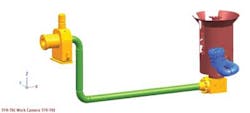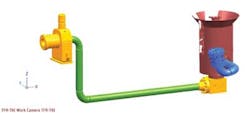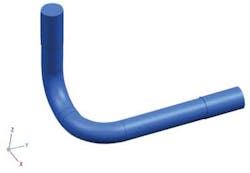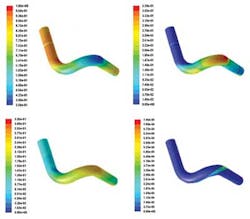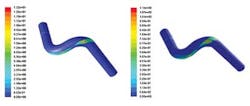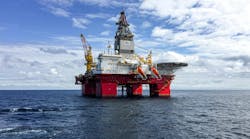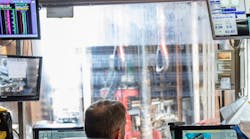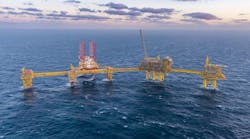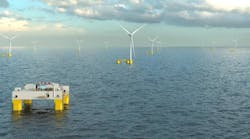Ahmad H. Haidari, Ph.D.
ANSYS Inc.
Advances in equipment and technology contribute to making it possible to produce more oil from old fields and deepwater reservoirs and to reducing the associated financial risk. Project success may depend on improving resource recovery as well as managing cost and reliability of processing, separation, and flow-control equipment. To process continuous flows of oil, water, gas, and sand at dynamic operating conditions, equipment must operate reliability in harsh environments with minimal human intervention and limited or no interruption. At the same time, there is increased emphasis on risk assessment for safety, equipment reliability, environmental impact, and regulatory compliance for offshore operations including produced water management.
Any proposed new technology must be conceived, designed, and developed to meet the highest performance standards under high-pressure/high-temperature and low-maintenance conditions; it also must incorporate the smart control systems that are being used more and more for offshore drilling and production. Seafloor installation of production and processing equipment is becoming a requirement to meet the operational and economic challenges in deepwater and arctic fields. Because of such complexities, engineering simulation tools can help develop current and next-generation subsea equipment for oil and gas production.
As installation and operation move to deeper water and more remote sites, some of the known engineering challenges become far more complex and require new engineering solutions. This is compounded by the fact that engineering workflow is transforming from single-component and single-physics design to systems engineering and multi-component, multi-physics simulations. Any advances in engineering simulation solutions must meet combine engineering simulation and experimental validation for component and systems-level design.
Advances in computational science in electronic, electromagnetic, fluid, thermal, and structural mechanics combined with integration into a common platform enable both single-component and full-systems engineering. Through simulation-driven product development — in which modeling and simulation are used upfront in the design cycle to drive new solutions, rather than to merely verify existing ones — many aspects of engineering analysis and design related to oil and gas production and processing equipment can be evaluated using virtual prototyping long before manufacture and deployment. Through embedded optimization and parameterization technology, it is possible to develop robust designs. These practices lead to simple and well-designed equipment that meets quality, durability, and dependability specifications for subsea projects.
Challenge of produced water
One continuing challenge is to manage produced water efficiently. Water occurs naturally within oil and gas reserves, or it is used during oil and gas recovery. Regardless, it is an undesired byproduct. Both onshore and offshore production requires special handling and processing that uses pumping energy for separation, transport, disposal, and recycling. The problem is greatest with old wells and deepwater production. For many years, researchers have investigated installing seafloor equipment to process the produced water. Making this concept viable requires that equipment be low maintenance and reliable with minimal external intervention. These installations can have enormous impact on increasing yield from oil reservoirs, improving operational efficiency by reducing equipment and piping costs, and overcoming regular slowdowns and production stoppages due to processing equipment bottlenecks.
As the distance between production and collection sites gets longer, the engineering challenges increase , especially maintaining operational excellence, reliability, and cost efficiency. Engineering simulation tools can benefit the design of complex piping systems that transport oil and gas long distances under harsh operating conditions – including water management in complex equipment and new flow assurance solutions. Structural mechanics concerns come into play with fatigue and pipe buckling. In addition, coupled multi-physics capabilities are required to account for the interplay of electronics with fluids, temperature, and vibration. New technologies for transmission, subsea power systems, power cables, subsea installation, and intervention applications present challenges including thermal and electromagnetic management, electronic induction on electronic circuits, wireline tools, sensors, and wireless devices, and logging-while-drilling.
Sand management tool
Another area that requires attention is sand management, including its abrasive impact on downhole tools, processing and transport equipment, and pipelines. Sand particles impact fluid handling equipment surfaces and can remove material to the point of severe damage. This increases maintenance and monitoring costs and can lead to equipment loss and production downtime.
To control erosion, engineers must analyze a range of parameters including fluid proprieties, particle size and distribution, wall materials, geometry, particle loading, and local flow and particle velocity impact. Of course, the process is more complicated when the flow is three or more phases.
Engineering simulation software can investigate multi-phase flows in oil and gas production for sand management in general, and for erosion effects in particular. For simple geometries, it is possible to model and gauge peak erosion using empirical methods. Alternatively, three-dimensional engineering simulation is used to examine flow distribution, local particle concentration, and the resulting erosion profile.
In contrast to correlation or mechanistic models in which erosion is calculated from single-phase or mixture properties, engineering multi-phase simulation enables detailed calculation of particle concentration and impingement velocity in the presence of multiple phases and in any type of geometry.
To illustrate the capability and utility of engineering simulation, consider this numerical investigation: FMC Technologies looked at erosion involving four-phase flow (water, oil, sand, and gas) in a subsea flow loop. The simulation was performed for 200 micron particles at the rate of more than 200 lbs of sand per day. The fluid phase included gas (volume fraction 0. 75), water (volume fraction 0. 012) and oil production of 19,000 PBD. The study focused on the upstream portion of the flow loop.
Detailed engineering simulation provides a number of benefits. It is possible to extract results, visualize and analyze cause and effect, and conduct virtual experiments. All geometrical, flow, and process parameters can be modified to simulate a range of real-world conditions.
Since the entire domain, including pipe material proprieties and particle characteristics, are included in the simulation, it is possible to solve for sand erosion. The engineer visualizes and understands where the particles have the most surface impact and so can calculate metal erosion rate.
In this investigation, the simulations analyzed different gas flow rates, resulting in a better understanding of the regions and operating parameters. This information then can be used to design the loop with reduced particle surface impact and/or to develop an erosion reduction and management solution.
This example demonstrates that high-fidelity engineering simulation can be used to gain insight into the well stream covering both complex geometries and complex physics. Specifically, these simulations concluded that the erosion rate is significantly mitigated depending on characteristics of the flow regime.
Summary
Engineering simulation technology is evolving to study systems behavior. It can simulate many subsystems to examine novel concepts and configurations, as well as physical conditions that equipment faces in the real world. Engineering new technology for oil and gas installation and operation on the seafloor requires consideration of complex multi-phase flow, thermal factors, vibration, structural mechanics, nonlinear material behavior, and electronics systems – alone and in combination. In addition, since seafloor processing systems work under a range of conditions without operator intervention, engineers must develop and perfect monitoring and separation methods for these new systems. Also, it is important to reduce equipment complexity to increase reliability. Electronic and control systems must be designed to reliably service subsea installations; ROVs will need to be developed and deployed to build and maintain seafloor equipment.
Applications of simulation science in design of equipment and oil and gas subsystems increasingly complement established engineering practices. Best-practice engineering design processes combine existing knowledge, correlations, reduced-order models, and physical experiments with detailed engineering simulations to create a powerful design and analysis platform. Well established design processes, upfront simulations, and validations when required continue to create greater confidence that the results from high-fidelity engineering simulations are trustworthy. Leading companies leverage this knowledge to improve and develop the next set of technology for offshore and subsea drilling, production, and process equipment and systems.
Author
Ahmad H. Haidari, Ph.D, is the Global Industry Director, Energy and Process Industries, ANSYS Inc.
Acknowledgment
The author acknowledges Dr. Egidio Marotta, manager of the Multi-Physics Simulations Group at FMC Technologies' North America Technology Center and members of his team for sharing simulation data of the subsea flow loop used in this article.
Offshore Articles Archives
View Oil and Gas Articles on PennEnergy.com
